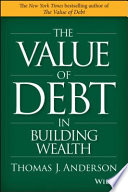

Finally, the book emphasizes the importance of adopting a long-term perspective on wealth building. The author argues that successful wealth accumulation requires patience, discipline, and a willingness to take calculated risks. By focusing on long-term goals rather than short-term gains, readers can make more strategic financial decisions. The book encourages readers to develop a wealth-building plan that incorporates debt as a tool for growth, rather than a hindrance, and to remain committed to their financial objectives over time.
Continue readingThe book emphasizes that debt is not inherently bad; rather, it is a financial tool that can be leveraged to build wealth. The author discusses how successful investors and entrepreneurs utilize debt strategically to amplify their returns. This idea challenges the conventional wisdom that all debt is detrimental, instead framing it as a means to access capital that can lead to greater financial opportunities. The author illustrates this point with case studies of individuals and businesses that have effectively used debt to finance investments that yield higher returns than the cost of the debt itself. By understanding the nuances of different types of debt—such as good debt versus bad debt—readers can better navigate their financial landscapes and make informed decisions about borrowing.
Continue readingLeverage is a key concept in the book, defined as the use of borrowed capital to increase the potential return of an investment. The author explains how leveraging debt can magnify gains, particularly in real estate and business investments. However, the book also cautions about the risks involved with high leverage, including the potential for significant losses if investments do not perform as expected. Through various examples, the author demonstrates how the right level of leverage can lead to wealth accumulation, while also providing strategies for managing risk. This idea encourages readers to consider how they can use leverage responsibly to enhance their investment strategies.
Continue readingEffective debt management is crucial for building wealth, and the book provides practical strategies for managing both personal and business debt. The author discusses methods for prioritizing debt repayment, consolidating loans, and negotiating better terms with creditors. Additionally, the book emphasizes the importance of maintaining a healthy credit score, as it can significantly impact borrowing costs. By outlining actionable steps for managing debt, the author empowers readers to take control of their financial situations and make decisions that align with their wealth-building goals.
Continue readingA major theme in the book is the distinction between assets and liabilities, and how debt can be used to acquire assets that generate income. The author explains that while liabilities drain resources, assets can provide cash flow and appreciation. By using debt to invest in income-producing assets like real estate or businesses, individuals can create wealth over time. The book encourages readers to shift their mindset from viewing debt as a burden to seeing it as a means to acquire valuable assets that contribute to long-term financial stability.
Continue readingThe importance of financial education is a recurring theme throughout the book. The author argues that a lack of understanding about debt and finance can lead to poor financial decisions and missed opportunities. The book advocates for continuous learning about personal finance, investment strategies, and debt management. By equipping themselves with knowledge, readers can make informed choices that enhance their financial well-being. The author also provides resources for further education, including books, courses, and online tools.
Continue readingThe book delves into the psychological factors that influence how individuals perceive and manage debt. The author discusses common fears and misconceptions about debt, such as the stigma of being in debt or the anxiety associated with repayment. By addressing these psychological barriers, the book aims to empower readers to adopt a healthier mindset towards debt. This idea highlights the importance of emotional intelligence in financial decision-making and encourages readers to confront their fears and reframe their understanding of debt.
Continue reading